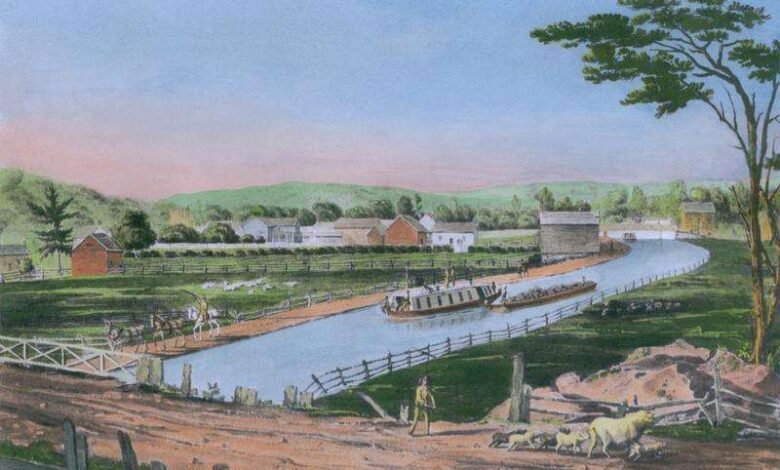200 Years of Erie Canal History (1825-2025)


 In 2025, New York State commemorates the 200th anniversary of the opening of the Erie Canal from Albany to Buffalo. This event was transformative for both the state and the nation, linking the Great Lakes with the Hudson River and the Atlantic Ocean in an unprecedentedly efficient waterway.
In 2025, New York State commemorates the 200th anniversary of the opening of the Erie Canal from Albany to Buffalo. This event was transformative for both the state and the nation, linking the Great Lakes with the Hudson River and the Atlantic Ocean in an unprecedentedly efficient waterway.
During the bicentennial, we are offered an opportunity to reflect on two centuries of rich and complex history and discover how that period’s impacts allow us to explore and enjoy the Canal today. Here is some history, and tips for enjoying the canal.
A History of the Erie Canal
The story of the Canal begins thousands of years ago, when melting glaciers carved out the Mohawk and Hudson River Valleys, creating a rare passage through the Appalachian Mountains.
Over the ensuing centuries, the Seneca, Cayuga, Onondaga, Oneida, Mohawk, and Tuscarora nations united into the Haudenosaunee Confederacy and utilized the natural waterways of the region for trade, travel, communication, and warfare.
European settlers began arriving in the Mohawk Valley in the 1600s, also recognizing the transportation advantages of these waterways, though the Mohawk River was not well suited for market production in its natural state.
The American Revolution dramatically changed the dynamics in upstate New York, as differing alliances fractured Haudenosaunee unity. Genocidal campaigns further weakened and dispossessed the land’s Indigenous inhabitants, and American veterans were granted lands there in payment for their service.

 Following the Revolution, land speculators and politicians like George Clinton and Philip Schuyler attempted to encourage further settlement of the future Canal Corridor by entering into dishonest and often illegal treaties with the Haudenosaunee, as well as chartering transportation improvements such as the Western Inland Lock and Navigation Corporation in 1792, which aimed to improve the Mohawk River’s navigation through the construction of dams, locks, and small canals.
Following the Revolution, land speculators and politicians like George Clinton and Philip Schuyler attempted to encourage further settlement of the future Canal Corridor by entering into dishonest and often illegal treaties with the Haudenosaunee, as well as chartering transportation improvements such as the Western Inland Lock and Navigation Corporation in 1792, which aimed to improve the Mohawk River’s navigation through the construction of dams, locks, and small canals.
In the first decade of the 1800s, a movement began to grow, advocating for state and federal funding of an artificial waterway between the Hudson and the Great Lakes. Eventually, DeWitt Clinton arose as the leader of this movement.
In 1817, the State Legislature narrowly approved the construction of a canal and shortly thereafter Clinton was elected governor. As he was celebrating in the city of New York, a smaller ceremony was also occurring in Rome, NY, where the first shovelful of dirt on the Erie Canal was turned.
Beginning in the middle section of the state, New York’s young engineering corps, led by Benjamin Wright and James Geddes, was strategic in building the least challenging section of the canal first, connecting Utica on the Mohawk River to Montezuma on the Seneca River, over 90 miles of canal, in a mere three years.
Work then moved onto the more technically complex Eastern and Western Divisions, which saw an increasingly immigrant workforce construct engineering marvels, including enormous aqueducts and the famous Lockport Flight of Five locks.

 Work was completed in October 1825 and a grand celebration took place across the state as DeWitt Clinton traveled aboard the Seneca Chief from Buffalo to New York Harbor, where he ceremonially poured a barrel of Lake Erie water into the Atlantic, symbolizing a “Wedding of the Waters.”
Work was completed in October 1825 and a grand celebration took place across the state as DeWitt Clinton traveled aboard the Seneca Chief from Buffalo to New York Harbor, where he ceremonially poured a barrel of Lake Erie water into the Atlantic, symbolizing a “Wedding of the Waters.”
The opening of the canal had enormous impacts, felt almost immediately. The journey from Buffalo to the city of New York was cut from one month to one week, while shipping prices were slashed to one-tenth what they had previously been, leading to an explosion in trade between the Eastern seaboard and the Midwest.
New York City quickly established itself as America’s preeminent port. New cities like Buffalo, Rochester, Syracuse, and Utica arose on its banks as critical transportation and industrial centers.
Preachers and reformers moved along the canal’s waters, creating the “Burned Over District,” where hugely impactful movements including Mormonism, Spiritualism, Anti-Masonry, and women’s rights took root, while existing movements like abolition and temperance found fertile ground for expansion.
More canals were built in the coming decades, in both New York and other states, attempting to emulate the Erie’s success. None ever did, but these canals did have tremendous impacts on the development of the towns they went through.
The coming of the Erie Canal, however, further exacerbated the dispossession of the Haudenosaunee and other Indigenous nations farther to the west. Additionally, its construction and operation by immigrant and child laborers, most of whom never enjoyed the massive wealth they helped create, led to a host of social problems that both middle-class reformers and the workers themselves would attempt to rectify to varying degrees of success.
Meanwhile, massive environmental degradation was brought about by the industrial society that sprang up along its banks, the effects of which New Yorkers still grapple with to this day.
By the end of the 19th century, railroads began to outpace the canal. In response, New York built the Barge Canal System, completed in 1918, which canalized natural waterways like the Mohawk and Seneca Rivers. Though the canal remained a key commercial route until the opening of the St. Lawrence Seaway, it gradually lost economic importance.
Rebuilt, rerouted and enlarged three times, New York still operates the Erie Canal today, which connects Albany to Buffalo and serves as a recreational route for boaters during its navigation season. The canal has also become a great destination for cyclists with the completion of the Empire State Trail in 2020, which follows much of the canal’s historic route, drawing millions of visitors annually.
Recreational boating is now a core part of the canal’s identity and the New York State Canal Corporation is charged with maintaining the Erie Canal, along with the Champlain, Oswego and Cayuga-Seneca Canals – collectively known as the New York State Canal system. Local, county, state and federal efforts work to keep the legacy alive through the promotion of inclusive and accessible water and land-based recreation.
They help support and promote the 200+ communities along the Canal Corridor with focuses on environmental stewardship, arts, tourism and culture. Two centuries later, the Erie Canal is still connecting people, places and ideas.
Celebrating the Anniversary
The Erie Canal is scheduled to open for the 2025 navigation season on Friday, May 16, and in honor of the bicentennial, the season will run several weeks longer than usual, ending on Monday, November 3rd.
To further help celebrate the bicentennial of the Erie Canal, there are countless opportunities to connect with the canal during this anniversary year:
- Try the On the Canals excursion, which offers a variety of free, accessible programming across the Canal system.
- Visit a New York State Park or Historic Site along the canal. Schoharie Crossing is dedicated to interpreting the history of the Erie Canal and has several historic canal structures to experience. The 36-mile Old Erie Canal State Historic Park offers chances to explore canal history while biking, walking, jogging or more. Many other parks and historic sites are located near the canal for an ideal day trip.
- Catch the Seneca Chief, a replica of the boat Governor DeWitt Clinton used for his inaugural sail from Buffalo to New York Harbor, as it passes through a town near you beginning in September.
- Are you a cyclist? You can ride The Empire State Trail from Buffalo to Albany with hundreds of participants from around the world by signing up for Cycle the Erie Canal tour.
- Interested in volunteering? Participate in Canal Clean Sweep April 15th and join thousands of volunteers in helping clean up our state’s greenways and canalways in preparation for the summer season.
- And there’s more in the works for this summer. From local festivals and events to an upcoming partnership with the Albany Symphony Orchestra, where they’ll be performing free concerts at canal locations across the state, find out more about what’s on the horizon.
The history of the Canal continues up to the present. That history is shaped by all of us, who have the opportunity to make the next 200 years of the Erie Canal history as significant as the last.
Read more about the Erie Canal.
A version of this essay first appeared in the New York State Parks and Historic Sites Blog. It was written by Derrick Pratt, Director of Education and Public Programs at the Erie Canal Museum; Jackie Schillinger, Senior Communications Strategy Manager, NYS Canal Corporation; and Tyler Wilcox, Community Relations Representative, NYS Office of Parks, Recreation, and Historic Preservation.
Illustrations, from above: The Erie Canal in 1829; the Deep Cut at Lockport, NY, blasted out of the Niagara Escarpment to allow Lake Erie water to feed the western section of the Erie Canal (courtesy Erie Canal Museum); Dewitt Clinton on Seneca Chief with representatives from places along the route of the new Erie Canal (DeWitt Clinton High School painting, 1911); and an aerial view of Erie Canal Lock 6 part of the Waterford Flight of Locks (Photo by Philip Kamrass, provided by NYPA and Canal Corp).
Source link





